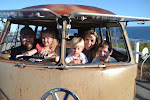When you head to a place like Tassie, with all it's National Parks and World Heritage areas, you expect to see a few possums or a kangaroo or two. But when Luke and I decided to head over to Bruny Island, off the coast of Hobart, for a night, we had no idea that we were going to have that many animal encounters, that we may as well have bought two tickets to the Irwin's Australia Zoo on the Goldcoast.
Bruny Island is made up of two islands, joined by a sand road or 'neck' where a bunch of penguins and shearwater birds nest each and every night (of course!). A $25 return ticket for all three of us (the two Tonkins and kombi Jefro) and we were off on a 30 minute trip on our second car ferry in a matter of weeks. Oh, didn't you know? Hanging out on car ferries is very now, darrrling!
Aww... cute! There were random pink looking jelly fish in the ocean, bush hens wandering around the toilet block, but the thing that most campers come to see, is the white wallabies. Yep, white.


Apparently, these little guys have an albino gene and because they have no natural predators on Bruny Island, they've been able to interbreed and now they hop freely about the Eco Reserve. We weren't lucky enough to see the white possums (expect for one road kill which was too sad) and 'blondie' the resident white echidhana that roams the grounds (I'm seriously not lying - these creatures exist here!) but seeing a white wallaby up close and personal was enough to get us excited. Gee, with this kind of scenery, $20 for an overnight spot is a bargain!
But the excitement (or the animals) didn't stop there. Grab some red cellophane from the park office and head 20minutes back out to the 'neck' and join the rest of the campers to watch the local penguin colony as they make their nightly stroll up the beach, back to their nests. This is really an amazing experience and not one you get to do for free in anywhere else I know of in Australia. There's a National Park ranger on duty each night at the 'neck' boardwalks, who'll tell you all about the cute little critters who mate for life and take it in turns to hunt each day, while their partner looks after the nest and egg. Perhaps we humans have something to learn from these clever birds? Huh? But for now, Luke and I are content to watch and listen to these little guys in the darkness. Our Tasmanian wildlife quota is maxed in just one day.








No comments:
Post a Comment